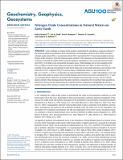Nitrogen Oxide Concentrations in Natural Waters on Early Earth
Author(s)
Ranjan, Sukrit; Todd, Zoe R.; Rimmer, Paul R.; Sasselov, Dimitar D.; Babbin, Andrew R.
DownloadPublished version (1.679Mb)
Publisher with Creative Commons License
Publisher with Creative Commons License
Creative Commons Attribution
Terms of use
Metadata
Show full item recordAbstract
A key challenge in origins-of-life studies is estimating the abundances of species relevant to the chemical pathways proposed to have contributed to the emergence of life on early Earth. Dissolved nitrogen oxide anions (NO-[subscript x]), in particular nitrate (NO-[subscript 3]) and nitrite (NO-[subscript 2]), have been invoked in diverse origins-of-life chemistry, from the oligomerization of RNA to the emergence of protometabolism. Recent work has calculated the supply of NO-[subscript x] from the prebiotic atmosphere to the ocean and reported steady state [NO-[subscript x] to be high across all plausible parameter space. These findings rest on the assumption that NO-[subscript x] is stable in natural waters unless processed at a hydrothermal vent. Here, we show that NO-[subscript x] is unstable in the reducing environment of early Earth. Sinks due to ultraviolet photolysis and reactions with reduced iron (Fe[superscript 2+]) suppress [NO-[subscript x]] by several orders of magnitude relative to past predictions. For pH = 6.5–8 and T = 0–50 °C, we find that it is most probable that [NO-[subscript x]] <1μM in the prebiotic ocean. On the other hand, prebiotic ponds with favorable drainage characteristics may have sustained [NO-[subscript x]] ≥1μM. As on modern Earth, most NO-[subscript x] on prebiotic Earth should have been present as NO-[subscript 3], due to its much greater stability. These findings inform the kind of prebiotic chemistries that would have been possible on early Earth. We discuss the implications for proposed prebiotic chemistries and highlight the need for further studies of NO-[subscript x] kinetics to reduce the considerable uncertainties in predicting [NO-[subscript x]] on early Earth.
Date issued
2019-04Department
Massachusetts Institute of Technology. Department of Earth, Atmospheric, and Planetary SciencesJournal
Geochemistry, Geophysics, Geosystems
Publisher
American Geophysical Union (AGU)
Citation
Ranjan, Sukrit, et al. “Nitrogen Oxide Concentrations in Natural Waters on Early Earth.” Geochemistry, Geophysics, Geosystems 20, 4 (April 2019): 2021–39. © 2019 The Authors
Version: Final published version
ISSN
1525-2027